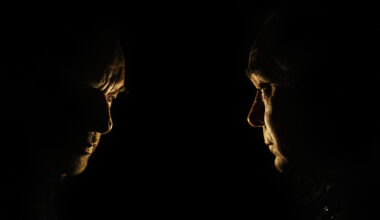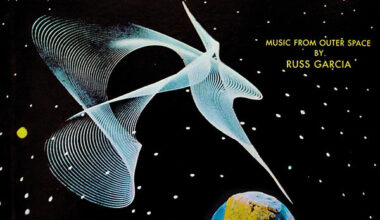It’s been almost 20 years since we’ve had the pleasure of a lesser-spotted Chris Carter solo album. Brewed up and shot through with the influence of his late, great TG pal, Sleazy, ‘Chemistry Lessons Volume One’, is something very special indeed…
Chris Carter is a linchpin of British electronica. As a founding member of Throbbing Gristle, perhaps Britain’s most alarming electronic music art project, along with his other “wreckers of civilisation” (they really should slap a trademark on that phrase), Genesis P-Orridge, Cosey Fanni Tutti and Peter Christopherson, he helped create a world of sound that would abide long after the shock wore off. For someone who played such a central role birthing the UK electronic music scene, he’s a modest and unassuming chap. He’s at his happiest discussing oscillators and circuit boards, as if his prodigious talent for creating affecting electronic music is a by-product of his soldering skills.
“When people travel,” he says, “they might take a book to read. I take manuals to read. I love a good manual.”
We’re talking to Chris because his new solo album, ‘Chris Carter’s Chemistry Lessons Volume One’, or ‘CCCL’ for the sake of brevity, is a marvel. His first long-player in almost 20 years, its 25 short pieces (the longest is almost five minutes; most are around two or three minutes long) each deliver a spine-tingling blend of melody and electronic texture.
Before we talk at the University of Surrey’s impressive music department, where he is taking part in a Moog Labs event, he is chatting happily to modular synth designers and fellow practitioners about product development and circuit board acquisitions. It’s clear this is his happy place. “I like talking shop,” he later confirms with a smile. And with Carter, this is literally shop talk; his modular collaborations, the TG One with Tiptop Audio and The Gristleizer from Future Sound Systems, are doing well in the mad modular marketplace.
The technical has always been at the root of Carter’s work, pre-dating his role in Throbbing Gristle. Before TG, when he began helping to terrify the nation with their mix of punishing electronics, noise, shocking imagery and confrontation tactics, Carter worked in TV as a sound engineer (he actually held his day job for some time into TG’s notoriety). He was also creating light shows for music festivals and touring his own multimedia installations, floating around the same post-hippy, pre-punk underground counter-culture circuit where Genesis P-Orridge, Cosey Fanni Tutti and Peter “Sleazy” Christopherson were to be found, outraging public decency with their COUM Transmissions work.
When the four joined forces and formed TG, he became the band’s technical powerhouse, a back-room figure who left the headline-grabbing work to his more outgoing bandmates, while he fuelled the TG industrial complex with electronic energy. Throbbing Gristle traded in the extreme, but it seems to me that Chris isn’t an extreme person.
“No, I’m not,” he agrees, mildly.
But there he was, in the middle of what was a pretty forbidding scene, its gaze firmly fixed on the darker side of humanity, with its references to serial killers, a studio called the Death Factory and the like, not to mention its occupation of – perhaps even the very defining of – the intersection of kink, direct-action politics and sex art, and attracting some pretty out-there characters as a result.
“Yeah, it did attract people,” nods Carter, “but because I kept myself busy doing all the nuts and bolts of Throbbing Gristle, I didn’t focus on it as maybe I should have at the time.”
His world, he confesses with disarming candour, was filled with his feelings for Cosey (“I was madly in love with her”) and the technical side of TG.
“It’s only looking back now and having read Cosey’s book that I think how mad and ridiculous some of it was, and how extreme some of it was. But when you’re in the middle of it, it’s like the eye of the storm being the calmest place. It often was for me. There were all sorts of things that Gen or Sleazy were doing that didn’t really click until much later.”
Throbbing Gristle invented the idea of industrial music, but the tag wasn’t about a sound, it was a lifestyle. The term had been in the TG/COUM lexicon for some time, but as they were preparing to unleash Throbbing Gristle on the world, with the music, the logo and the manifesto all worked out, they lacked a pithy mission statement that would bring it all together. It was cat-burning American artist Monte Cazazza (he once immolated a dead cat and forced his captive audience to witness it… at gunpoint) who gave Genesis the phrase, “industrial music for industrial people”, and for Carter this was about industriousness, organising your own labour for your own projects. It was the DIY ethic that is more regularly credited to punk, despite the fact that the Pistols, The Clash and The Damned all signed to major labels as soon as was humanly possible.
“It was a concept and a way of life,” he says. “It was the whole cottage industry, DIY thing. It was really important for us.”

And the DIY approach remains central to Carter’s proposition, although as it happens, ’CCCL’ is coming out on Mute Records. Mute are seen as the British institution that has done so much to keep interesting electronic music available and in the public eye, through its reissues of the Industrial Records catalogue and support of some key marginal artists. He points out the contradiction before I do, with a wry chuckle, but much of Chris & Cosey’s output and re-releases have been put out on their own label, in their own time, in their own way.
‘CCCL’ shares the abstract, experimental nature of his previous work, but there’s a new focus, and an emotional heft that goes straight to the heart.
Part of that emotional tug comes from the melodies that haunt the album, delivered by peculiar hypnotising voices. They lend proceedings a supernatural aura. ‘CCCL’ plays with Britain’s Radiophonic past, with humorous interludes like ‘Nineteen 7’, but it’s this spine-tingling haunted spirit that makes it stand out. And in a way, it is haunted, possessed by the spirit of Peter “Sleazy” Christopherson, Carter’s former Throbbing Gristle bandmate who passed away suddenly in 2010.
“I was working with Sleazy on this idea of using the voices,” says Carter. “He did this project called The Threshold HouseBoys Choir where they were going to use software as a vocalist. I wasn’t involved, but I’d been working with him, giving him ideas. When that project fell apart for whatever reason, we started working on ideas that we could use when we did X-TG [the post-reformed Throbbing Gristle, which existed briefly between Genesis P-Orridge leaving the band in October 2009 and Christopherson’s death in November 2010]. We started out working on those vocals as an experiment.”
The album, then, is the end product of a long and sometimes painful process, which began with the experiments with Sleazy and solo jams recorded as a release valve for Carter; work that would occupy him without any of the deadline pressure that was on him during the Throbbing Gristle/X-TG era. He continued to craft the release as Carter Tutti got going again, and it was completed while Cosey was writing her extraordinary memoir, ‘Art Sex Music’.
“It was nice to do something else,” he says. “I was just dabbling; I had a little Zoom recorder plugged into the gear so I could hit record, and I kept recording while I was dabbling, and it slowly came together. I’d done quite a lot of tracks, and then Sleazy died.”
He stops and shakes his head.
“It hit me so badly, all of a sudden,” he says, quietly. “It hit all of us. And I just stopped. It took me a year to get back into it because every time I went to listen to it, it reminded me of him.”
Chunks of inspiration, however, came from a hard drive that belonged to Sleazy, which Carter was sent following his friend’s death.
“I went through the music on this hard drive and there was a folder filled with all kinds of different things,” says Carter. “There were these folk songs on there. Some of them a very old, medieval, and that’s where I got some of the melodies from.”
Which explains why ‘CCCL’ sometimes comes across like a soundtrack to Russell Hoban’s 1980 novel, ‘Riddley Walker’, a dazzling and often gruelling depiction of England 2,000 years after a nuclear war, bombed into a sparsely populated dark age, its cowering tribes of remaining humans locked into a fearful belief based on scraps of ‘The Bible’, word-of-mouth history and foundation myths about their ancestors.
The folky post-technology quality of ‘CCCL’ and its synthesised medieval darkness is summoned up by the electronic voices which articulate its oscillators into extended vowels and plosives, to mesmerising effect. It’s unearthly and uncanny. It first comes to the fore in the ethereal ‘Tangerines’ and swirls across the gorgeous ‘Cernubicua’ and ‘Pillars Of Wah’. It’s the question on everyone’s lips at the Moog Labs event: “How did you make those sounds?!”
“When we started experimenting with them for X-TG,” explains Carter, “Sleazy had bought a Kyma Pacarana, a really expensive, deep hardware synth, but it wasn’t really going the way I wanted, although the technique was sound. Then we bought an Eventide H-8000 [another incredibly high-end piece of kit] and we were going to marry the two together. I also had a Roland V-Synth that does weird vocal things… I could probably tell you how I did each one if I could go back to the multi-track.”
The post-digital-age process of trawling through the hard drive of deceased loved ones is a special kind of sad, and it could be said that it is imprinted into the music on ‘CCCL’; perhaps the spirit of Sleazy energises it.
“The experiments we’d been doing together were on that hard drive, and I was compiling quite a lot of stuff with no real idea of what I was going to do with it. It was odd…”
There are some gigs in the pipeline, though he’s been turning offers down in an attempt to fashion a strategy for the release cycle of the album, alongside the Mute re-issues of the remaining Throbbing Gristle back catalogue, plus the album’s title drops a heavy hint that we might expect another volume at some point in the future. Carter affirms that ‘Volume 2’ is in the blocks.
“It will be quite different from ‘Volume 1’,” he says. “I have quite a lot of tracks done already; I’m still working on different things, so anything could happen. I love weird sounds. I like mixing them with straight sounds, and I like it when people don’t know what that sound is. I have different hats for different projects. I can’t say I have a methodology, because all the projects I work on vary so much, and they all overlap.”
Is there a methodology that informs the output?
“I use chance,” he says. “The bulk of the album is chance. I am musically dyslexic. I have to have notes written on a keyboard because when I look at the keyboard I don’t often see the gaps, you know – the black notes. Sometimes it just looks like they’re all the same, just the same space.”
Or ‘The Space Between’, perhaps…
‘Chris Carter’s ‘Chemistry Lessons Volume One’ is out on Mute






